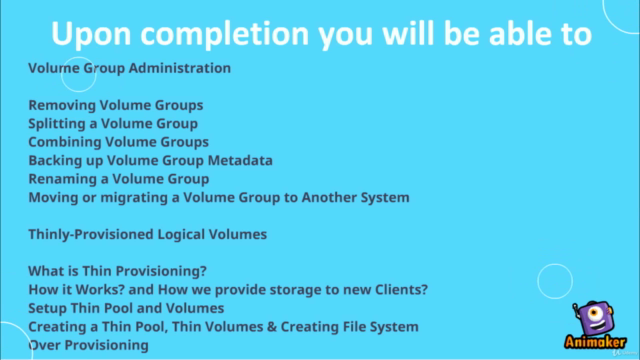A Complete Guide on Linux LVM

Why take this course?
🧭 A Complete Guide on Linux LVM: Master the Art of Logical Volume Management!
Course Description
Embark on a comprehensive journey through the intricacies of Linux Logical Volume Management (LVM) with our expert-led course. Designed for learners ranging from beginners to advanced users, this course will equip you with both theoretical knowledge and practical experience. By leveraging hands-on lab sessions, you'll gain an in-depth understanding of LVM and its powerful capabilities to efficiently manage storage space on Linux systems.
Introduction - The Logical Volume Manager
LVM is a powerful tool for managing disk space in Linux that allows users to aggregate physical disk drives into pools of storage that can be divided into logical volumes as needed, allowing for more flexible and efficient use of storage.
LVM Components
The core components of LVM include:
- Physical Volumes (PVs): The basic building blocks of LVM, representing partitions or entire physical disk drives that are managed by LVM.
- Volume Groups (VGs): These pools of storage are created from one or more PVs and allow you to manage the combined space as a single unit.
- Logical Volumes (LVs): These are the file systems or other block devices within volume groups that present the actual usable logical storage volumes.
LVM Logical Volumes
Learn about the different types of LVs, including:
- Linear Logical Volumes: A straightforward type where each device (physical or otherwise) is used sequentially to store data.
- Striped Logical Volumes: These spread data and its associated metadata across multiple devices, which can improve I/O performance.
- LV Creation Options: Discover the various options available when creating LVs, tailoring them to your specific needs.
- Practice Lab Sessions: Apply what you've learned in interactive lab sessions that simulate real-world scenarios.
Physical Volume Administration
Gain expertise in:
- Creating and managing physical volumes.
- Scanning for block devices, displaying PVs, and preventing allocation on a PV.
- Resizing and removing physical volumes.
Volume Group Administration
Master the administration of volume groups by learning how to:
- Create and manage volume groups, including adding/removing PVs, displaying VGs, and activating/deactivating them.
- Change VG parameters, remove or split VGs, and back up VG metadata.
- Rename a VG or migrate it to another system.
- Set up mirrored volumes within volume groups for redundancy.
Thinly-Provisioned Logical Volumes
Understand thin provisioning, which allows you to provide more storage than is physically available by using metadata to track actual usage. Learn how to:
- Setup and manage a thin pool and volumes.
- Handle over-provisioning scenarios.
- Create file systems within thin volumes.
LVM Snapshot
Get hands-on with LVM snapshots, which allow you to save the state of a logical volume at a particular point in time for backup or rollback purposes. Learn how to:
- Create and restore LVM snapshots.
- Use snapshots for development and testing environments.
Recovering metadata of physical volumes
Discover techniques for recovering faulty disks and learn how to:
- Recover disk metadata in lab sessions, ensuring you're prepared for real-life data recovery challenges.
LVM Volume Attributes
Finally, explore volume attributes, including:
- Setting PV and VG attributes to control their behavior, such as I/O constraints, data integrity checks, and more.
By the end of this course, you'll be well-versed in LVM concepts and capable of handling a wide range of storage management tasks on Linux systems. Join us to transform your skills and unlock the full potential of Linux Logical Volume Management! 🚀💻
Course Gallery




Loading charts...